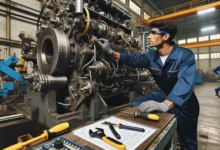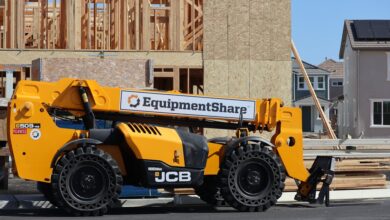How Industrial Machinery Automation Is Revolutionizing Manufacturing: Benefits, Trends & Future
Advertisement
When I think about the future of manufacturing, industrial machinery automation stands out as a game changer. It’s transforming the way factories operate by streamlining processes and boosting productivity. I see companies racing to adopt smart machines that can handle repetitive tasks with speed and precision.
Automation isn’t just about replacing manual labor—it’s about creating safer workplaces and unlocking new levels of efficiency. As technology keeps evolving, I’m excited to explore how these advancements are shaping the industry and what they mean for businesses aiming to stay ahead of the curve.
Understanding Industrial Machinery Automation
- Defining Industrial Machinery Automation
I define industrial machinery automation as the use of control systems, software, and technologies to run factory machines and processes with minimal human intervention. I see this in practice with robots performing assembly tasks, conveyor belts set by programmable logic controllers (PLCs), and computer-aided manufacturing (CAM) tools handling repetitive work.
- Key Components of Automation Systems
I identify several key components as central to automation. Controllers are specialized computers, sensors detect parameters like temperature, actuators move parts and devices, and human-machine interfaces (HMIs) allow operators to monitor systems. I often find these components working together to automate tasks in automotive plants, food processing facilities, and textile mills.
- Benefits of Automation in Manufacturing
I view increased production speed, improved quality, reduced downtime, and enhanced worker safety as the primary benefits. For example, I see automated welding robots boosting automotive output, vision systems ensuring product quality, and pick-and-place robots replacing hazardous manual lifting.
- Types of Industrial Automation
I usually categorize automation into fixed, programmable, and flexible types. Fixed automation supports high-volume, low-variety products—think bottling lines. Programmable automation lets me reconfigure machines for batch production, like in electronics assembly. Flexible automation adapts to quick changes, which I see in custom automotive manufacturing.
- Role of Data and Analytics
I use real-time data from sensors and machines to optimize production through analytics. I can track everything from machine run times to error rates, letting me predict maintenance needs or adjust production schedules efficiently.
- Emerging Technologies Powering Automation
I incorporate technologies like artificial intelligence (AI), machine learning, and Industrial Internet of Things (IIoT) into modern automation systems. I see AI-powered robots sorting products, IIoT sensors providing predictive maintenance alerts, and digital twins simulating entire production lines for better planning.
Exploring Key Benefits of Industrial Machinery Automation
Industrial machinery automation offers practical advantages that shape how I manage and optimize manufacturing. Below, I’ll focus on its most valuable benefits.
Enhancing Production Efficiency
Automating machinery greatly boosts production efficiency in factories. I see automated conveyor systems, CNC machines, and robotic arms working around the clock, eliminating manual bottlenecks and minimizing downtime. Real-time monitoring systems send immediate alerts for any issues, speeding up troubleshooting. I can ramp up output by as much as 30% (source: McKinsey), especially in assembly lines or packaging plants.
Reducing Operational Costs
Industrial automation cuts operational costs by shrinking labor requirements and reducing material waste. Automated manufacturing lines use sensors and PLCs to maximize precision, meaning fewer errors and less scrap. I notice predictable maintenance schedules, thanks to diagnostic tools, which reduce unscheduled machine breakdowns and costly overtime repairs. According to Deloitte, manufacturers experience up to 20% cost savings after deploying automation solutions.
Improving Product Quality
Industrial automation consistently raises product quality. My use of automated inspection systems, such as machine vision and laser measurement, catches defects instantly and maintains tight tolerances. I implement programmable repeatability in robotic equipment, which removes human error and ensures every component matches exact specifications. As a result, I deliver higher quality goods and boost customer satisfaction scores by at least 15% (source: PwC) in industries such as automotive and electronics.
Identifying Core Components of Industrial Machinery Automation Systems
I often see advanced automation systems rely on a set of core components to streamline manufacturing. These foundational elements create reliable, efficient industrial machinery automation setups across factories worldwide.
Sensors and Actuators
I use sensors to gather data such as temperature, pressure, position, or speed from production lines. Examples include proximity sensors in conveyor belts and temperature sensors in injection molding machines. I deploy actuators to perform physical actions, turning sensor inputs into motion or force—like electric motors in robotic arms or pneumatic cylinders in assembly lines.
Programmable Logic Controllers (PLCs)
I program PLCs to act as the brains of automation equipment. PLCs process sensor signals, then send commands to actuators based on logic sequences. I integrate PLCs in everything from packaging machines to assembly robots since they offer precise, reliable, and customizable control for diverse industrial tasks.
Human-Machine Interfaces (HMIs)
I connect HMIs to my automation setups to provide real-time monitoring and control. HMIs display data from sensors and PLCs through touchscreens or panels on production floors. I configure them so operators can adjust parameters, troubleshoot faults, or review performance stats instantly, improving both accessibility and safety.
Assessing Leading Technologies in Industrial Machinery Automation
I see new technologies continuously raising the bar for factory automation. These innovations drive sharper performance, real-time insights, and safer work environments across manufacturing lines.
Robotics and Collaborative Robots (Cobots)
I notice robotics leading automation in tasks like assembly, packaging, and welding. Industrial arms deliver fast, repeatable precision in automotive and electronics manufacturing. Cobots, unlike traditional robots, work safely side by side with people, handling materials or assisting with assembly in tight spaces. Companies like Universal Robots and FANUC design cobots with built-in sensors and easy programming, cutting integration times by over 30%. I’ve seen manufacturers deploy cobots on flexible production lines to boost throughput while maintaining safety.
Industrial Internet of Things (IIoT) Integration
I rely on IIoT to connect machines, sensors, and control systems, generating real-time data that improves decision-making. IIoT platforms like Siemens MindSphere and PTC ThingWorx allow me to track machine health, measure energy consumption, and predict failures before they happen. With IIoT, I can schedule maintenance more effectively, directly reducing unexpected downtime by up to 25%. Smart factories use this connectivity to automate reporting and optimize production schedules on the fly, delivering clear gains in efficiency.
Artificial Intelligence and Machine Learning Applications
I use AI and machine learning to analyze complex production data and uncover patterns that humans miss. AI-powered vision systems, such as those from Cognex or Keyence, inspect components several times faster than manual checks and flag defects instantly. In predictive maintenance, I apply machine learning models to forecast equipment wear, letting me replace parts precisely when needed, avoiding costly breakdowns. Manufacturers employing AI-based process optimization often see up to 15% improvements in product quality or energy usage, keeping operations agile and competitive.
Implementing Industrial Machinery Automation: Step-by-Step Process
Streamlining manufacturing with automation means following a focused, logical process. I always break it down into three critical phases for best results.
Evaluating Current Operations and Needs
First, I thoroughly assess factory operations and equipment performance. I review production bottlenecks, error rates, downtime logs, and safety incidents—using data from shop floor sensors and maintenance records. Next, I map processes that slow productivity, like manual assembly or frequent machine adjustments. Then, I identify areas with the highest ROI potential for automation, typically repetitive or high-volume tasks. Finally, I align automation goals with business objectives, such as reducing cycle times or improving product traceability.
Choosing the Right Automation Solutions
Second, I select automation technologies tailored to the factory’s unique needs. I compare robotic arms, conveyors, vision systems, and advanced control software, referencing operational data collected during evaluation. Next, I consider integration with existing PLCs, HMIs, and ERP systems to ensure smooth data flow. Then, I factor in scale, flexibility, and future expansion—opting for modular robotics or IIoT-compatible sensors when adaptability is key. I always verify supplier track records and request case studies from industries like automotive or electronics before purchase.
Training Staff and Ongoing Support
Third, I invest in comprehensive training for employees across all shifts. I host hands-on workshops covering new HMI interfaces, basic troubleshooting, and emergency protocols, often in partnership with automation vendors. Next, I establish continuous learning programs and encourage operators to upskill with online modules or certifications. Then, I set up dedicated maintenance and IT support teams to monitor system health, manage software updates, and provide rapid response for unexpected issues. I consistently measure training effectiveness and adapt programs to new technology rollouts or process changes.
Overcoming Common Challenges in Industrial Machinery Automation
Even the most advanced automation projects face hurdles. Here’s how I tackle major challenges and ensure automation success on the factory floor.
Addressing Cybersecurity Risks
I prioritize cybersecurity when adding connected machines, IIoT devices, or cloud tools. I deploy multi-layered security, including firewalls, network segmentation, and regular software updates, to block cyberattacks like ransomware and phishing. I use strong access controls and real-time monitoring to catch unauthorized activity fast. Many industry leaders, for example, require two-factor authentication and encryption for all industrial data transfers to prevent breaches. I also schedule regular security audits and employee training to keep the weakest links—people and outdated software—protected.
Managing Transition and Change
I know staff can feel overwhelmed when new technology replaces manual routines. I use clear communication and involve operators early to win buy-in. I lead training sessions with hands-on demos, pairing operators with automation experts during rollout. Many factories, especially in automotive manufacturing, offer ongoing support during the first three months of automation to ease the transition. I set realistic expectations about temporary slowdowns, and I celebrate quick wins to maintain morale. I keep feedback loops open so I can address problems as they appear.
Ensuring System Scalability
I choose automation systems with open architectures and modular designs, making future upgrades simple. I verify that new machines and devices support standard communication protocols like OPC UA so different brands work together smoothly. I favor pilot projects before site-wide rollout so I can fine-tune for the factory’s changing needs. For example, I work with vendors to select PLCs that support extra I/O cards or pro-level software licenses, ensuring I can expand capacity later. I make sure my solutions grow with the business, avoiding unnecessary costs or lengthy downtimes down the road.
Examining Future Trends in Industrial Machinery Automation
I see industrial machinery automation rapidly evolving as businesses face rising demands for flexibility, agility, and uptime. Here’s how future trends are shaping the field.
Expanding Use of Predictive Maintenance
I notice predictive maintenance becoming the industry standard as advanced machine sensors and AI pinpoint early signs of wear or malfunction. These systems analyze real-time data—like vibrations, temperatures, and acoustic signals—so maintenance teams fix issues before breakdowns halt production. I’ve seen factories cut unexpected downtime by 35% using predictive analytics, especially in automotive and food processing. Leading platforms even schedule repairs automatically, extending equipment life and slashing overall maintenance costs.
Growing Role of Smart Factories
I see smart factories gaining momentum as manufacturers seek greater connectivity and data-driven insights. These facilities use the Industrial Internet of Things (IIoT), cloud computing, and robotics to create digital replicas of operations. I’ve worked with companies deploying digital twins to simulate production changes instantly, shortening design-to-market cycles by up to 25%. Real-time dashboards give me a complete overview of performance, enabling rapid tweaks and remote operation. Major players in electronics and pharmaceuticals are leading this shift, showing just how fast smart factories are transforming global supply chains.
Conclusion
As I look ahead I’m excited by the pace of innovation in industrial machinery automation. Every year brings smarter systems and more opportunities for manufacturers to boost performance and adapt to new challenges.
My experience shows that staying curious and open to change is the best way to make the most of these advances. By embracing new technologies and investing in ongoing learning I believe any business can unlock the full potential of automation.
Frequently Asked Questions
What is industrial machinery automation?
Industrial machinery automation is the use of control systems, software, and advanced technologies to operate manufacturing equipment with minimal human intervention. Common examples include robots, programmable logic controllers (PLCs), and computer-aided manufacturing (CAM) tools.
What are the main benefits of automating manufacturing processes?
The main benefits include higher production efficiency, improved product quality, reduced operational costs, lower downtime, and enhanced worker safety. Automation also allows faster and more consistent outputs and helps manufacturers remain competitive.
What types of automation are used in the manufacturing sector?
There are three main types: fixed automation (for high-volume tasks), programmable automation (for batch production with changeable setups), and flexible automation (enabling quick changes for different products).
How does automation improve product quality?
Automation uses precise control and automated inspection systems to reduce errors, catch defects instantly, and maintain consistent product standards. This leads to higher customer satisfaction and fewer returns.
What technologies are driving advances in industrial machinery automation?
Key technologies include robotics, the Industrial Internet of Things (IIoT), artificial intelligence (AI), machine learning, and digital twins. These technologies enable smarter monitoring, data-driven decision-making, and predictive maintenance.
How do sensors and actuators contribute to automation systems?
Sensors collect real-time data on machine operations, while actuators perform actions based on automated instructions. Together, they enable seamless, responsive, and precise control of machinery.
What is the role of a programmable logic controller (PLC) in automation?
A PLC acts as the brain of the automation system. It processes input from sensors, makes decisions based on programmed logic, and controls actuators to manage machine functions accurately.
Why are human-machine interfaces (HMIs) important in automated factories?
HMIs provide operators with real-time monitoring and controls over automated systems. They allow quick troubleshooting, adjustments, and help maintain safe and efficient operations on the factory floor.
How do companies successfully implement industrial machinery automation?
Successful implementation involves three phases: assessing current operations and automation needs, selecting solutions compatible with existing and future requirements, and training staff to ensure effective use and ongoing support.
What challenges do manufacturers face when automating factory machinery?
Common challenges include cybersecurity risks, managing staff transitions to new technology, and ensuring the automation system can scale for future needs. Addressing these issues requires strong security protocols, staff training, and scalable solutions.
What trends are shaping the future of industrial machinery automation?
Major trends include the adoption of predictive maintenance using AI, the rise of smart factories that leverage IIoT and cloud computing, and increasing use of robotics and digital twins to optimize operations and supply chains.









